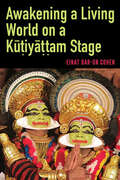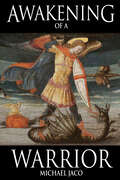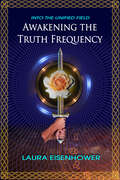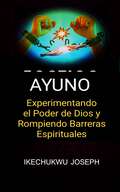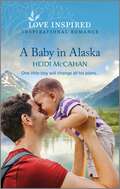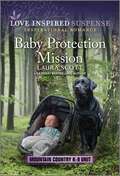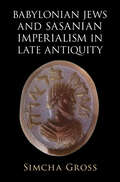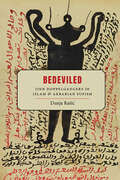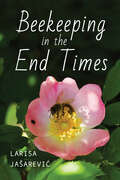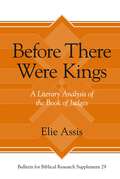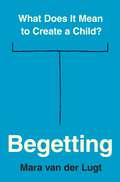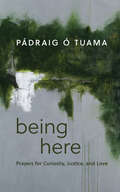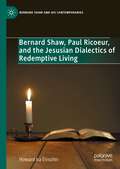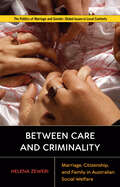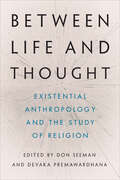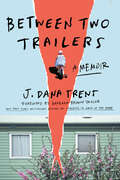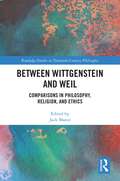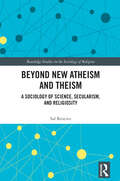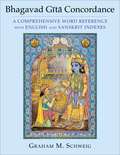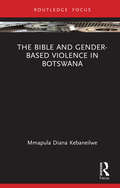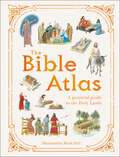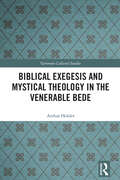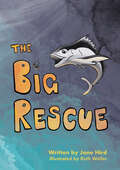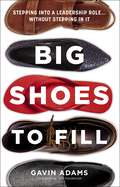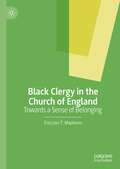- Table View
- List View
Awakening a Living World on a Kūṭiyāṭṭam Stage (SUNY series in Hindu Studies)
by Einat Bar-On CohenKūṭiyāṭṭam, an ancient form of Sanskrit theater from Kerala, was traditionally performed only in temples by members of two temple assistant castes. Today, however, it has spread to other castes and to venues outside temples. It is a fantastically complex, sophisticated, layered performance, toiling at amassing and perfecting ways of materializing a world where gods, demons, and mythical heroes live, bringing the audience into these other realities. Taking an anthropological approach, Awakening a Living World on a Kūṭiyāṭṭam Stage explores how Kūṭiyāṭṭam uses cultural dynamics, gleaned from temple ritual and theater, to remove the distinctions between mundane reality and the mediaeval plays being performed on stage. The unique features of Kūṭiyāṭṭam—makeup masks, enthralling drumming, delivering words in mudrā gestures, a shimmering lamp, male and female actors—all intertwine to animate stories from the great Indian eposes. Analyzing the cultural dynamics at work in Kūṭiyāṭṭam foregrounds a symbolic anthropology in which representation and symbols are shunned, while endless repetitions fill the stage with reverberating somatic intensities of profound depth. Thus, a new kind of living reality emerges that includes the protagonists of the play—gods, demons, humans, animals, and objects—together with the artist, the audience, and beyond.
Awakening of a Warrior: Past Lives of a Navy SEAL Remembered (Intuitive Warrior #2)
by Michael JacoNumerous great thinkers have believed in the transmigration of the soul. General Patton, Gandhi, Henry Ford, the Dalai Lama, all discussed memories of, or beliefs in, having past lives. The great philosophers Pythagoras, Socrates, Plato, Aristotle, and even Saint Augustine believed in the rebirth of the soul. Awakening of a Warrior is the result of Jaco' s investigation— his treasure hunt— into the lifetimes he experienced before the present.Included are his lives as King Abimelech of Gerar, who allied with Abraham in the creation of a new religion called Judaism; Cyrus the Great, who unified all of Persia and implemented Zoroastrianism as the state religion; and Marcus Furius Camillus, who came to be considered the second founder of Rome.
Awakening the Truth Frequency (Into the Unified Field)
by Laura EisenhowerLaura Eisenhower is a master astrologer and the great granddaughter to five-star general and 34th president Dwight D. Eisenhower. As a child, she intimately sensed the resistant forces working around her and embarked on her own journey into the underworld, only to discover her own truth frequency and overcome the many challenges in life by the remembrance of the divine feminine energies in union with the masculine, which is encoded in our DNA. Her experience has included extreme wilderness training and an attempted recruitment into living off-planet on Mars as part of the secret space program, which revealed to her many things. She declined, to stay true to her purpose here on Earth. She is quite informed of our galactic history, the different timelines of humanity, and the window period in which we are ascending in the Great Awakening.
Ayuno: Experimentando el poder de Dios y rompiendo barreras espirituales
by Ikechukwu JosephEste libro lleno de poder, "Ayuno (Experimentando el Poder de Dios y Rompiendo Barreras Espirituales)" es para todos los que tienen hambre de un caminar más cercano e intimidad con Dios, aquellos que necesitan libertad total, refrigerio espiritual, avivamiento, avance, superación de la sequedad espiritual, depresión, posesión demoníaca y obsesión. Este libro es una lectura obligada para todo creyente, guerreros de oración, hombres y mujeres de Dios. Fortalecerá su fe, le dará victorias, creará un nicho para usted en su generación. Aprenderá acerca de grandes hombres y mujeres de Dios que moldearon el mundo a través del ayuno y la oración, cómo romper fortalezas, limitaciones, gobernar en medio de sus enemigos, cómo conocer la mente de Dios, principios bíblicos de ayuno, tipos de ayuno, cómo romper ayunos de 3, 7, 21 y 40 días. Aprenda sobre el ayuno y la liberación, el ayuno y la guerra espiritual, y referencias bíblicas del ayuno. Obtenga su copia ahora y comience a gobernar su mundo y a romper barreras espirituales.
A Baby in Alaska: An Uplifting Inspirational Romance (Home to Hearts Bay #5)
by Heidi McCahanHe needs short-term help… But will he find a lasting love? Sam Frazier has three weeks in Alaska to acquire a small aviation company and serve as best man in a wedding—all with his infant nephew in tow. Thankfully, maid of honor and pilot Rylee Madden can&’t resist helping the new guardian, even if the acquisition might eliminate her job. The arrangement is temporary, and romance isn&’t an option. But will caring for baby Silas together change their minds?From Love Inspired: Uplifting stories of faith, forgiveness and hope.Home to Hearts Bay Book 1: An Alaskan SecretBook 2: The Twins' Alaskan AdventureBook 3: His Alaskan RedemptionBook 4: A Baby in Alaska
Baby Protection Mission (Mountain Country K-9 Unit #1)
by Laura ScottWhen a baby is targeted, can a K-9 team keep him safe? When his sister is kidnapped, rancher Cade McNeal will do anything to prevent his baby nephew from being next. Now Officer Ashley Hanson and her K-9 partner are on the case, and it&’s up to them to track down the assailant and keep Cade and his nephew from harm. But as the suspect list grows and the attacks escalate, will they bring a kidnapper to justice…before he strikes again?From Love Inspired Suspense: Courage. Danger. Faith.Mountain Country K-9 Unit Book 1: Baby Protection Mission by Laura ScottBook 2: Her Duty Bound Defender by Sharee StoverBook 3: Chasing Justice by Valerie HansenBook 4: Crime Scene Secrets by Maggie K. BlackBook 5: Montana Abduction Rescue by Jodie BaileyBook 6: Trail of Threats by Jessica R. Patch
Babylonian Jews and Sasanian Imperialism in Late Antiquity
by null Simcha GrossFrom the image offered by the Babylonian Talmud, Jewish elites were deeply embedded within the Sasanian Empire (224-651 CE). The Talmud is replete with stories and discussions that feature Sasanian kings, Zoroastrian magi, fire temples, imperial administrators, Sasanian laws, Persian customs, and more quotidian details of Jewish life. Yet, in the scholarly literature on the Babylonian Talmud and the Jews of Babylonia , the Sasanian Empire has served as a backdrop to a decidedly parochial Jewish story, having little if any direct impact on Babylonian Jewish life and especially the rabbis. Babylonian Jews and Sasanian Imperialism in Late Antiquity advances a radically different understanding of Babylonian Jewish history and Sasanian rule. Building upon recent scholarship, Simcha Gross portrays a more immanent model of Sasanian rule, within and against which Jews invariably positioned and defined themselves. Babylonian Jews realized their traditions, teachings, and social position within the political, social, religious, and cultural conditions generated by Sasanian rule.
Bedeviled: Jinn Doppelgangers in Islam and Akbarian Sufism (SUNY series in Islam)
by Dunja RašićGhouls, ifrits, and a panoply of other jinn have long haunted Muslim cultures and societies. These also include jinn doppelgangers (qarīn, pl. quranāʾ), the little-studied and much-feared denizens of the hearts and blood of humans. This book seeks out jinn doppelgangers in the Islamic normative tradition, philosophy, folklore, and Sufi literature, with special emphasis on Akbarian Sufism.Muḥyī al-Dīn Ibn ʿArabī (d. 1240) wrote on jinn in substantial detail, uncovering the physiognomy, culture, and behavior of this unseen species. Akbarians believed that the good God assigned each human with an evil doppelganger. Ibn ʿArabī’s reasoning as to why this was the case mirrors his attempts to expound the problem of evil in Islamic religious philosophy. No other Sufi, Ibn ʿArabī claimed, ever managed to get to the heart of this matter before him. As well as offering the reader knowledge and safety from evil, Ibn ʿArabī’s writings on jinnealogy tackle the even larger issues of spiritual ascension, predestination, and the human relationship to the Divine.
Beekeeping in the End Times
by Larisa JašarevićEvery hundred years, as the story goes, two angels wonder out loud whether the bees are still swarming. For as long as the bees are swarming, the angels are reassured, the world holds together. Still, the tale suggests, the angels live in anxious anticipation of the End. Local beekeepers in Bosnia and Herzegovina retell the old tale with growing unease, as their honeybees weather the ground effects of climate change.Beekeeping in the End Times relates extreme weather events and quieter disasters that have been altering honey ecologies across Bosnia and Herzegovina since 2014. While world-wide endangerment of pollinators, and bees in particular, has been the subject of much global concern, effects of climate change on the indispensable honeybees,remain understudied. Drawing on a five-year long study, the book suggests that local apiarists' field observations resonate with many climate biologists' concerns and speculations about the future of plant-bee relations on the warming planet. Local practice also adds to the record complex and puzzling trends that make honey scarce in otherwise lush, biodiverse landscapes.To Bosnian Muslims, honeybees are more than pollinators. They are inspired beings whose honey is another form of divinely revelation. To appreciate the meaning of honeybees and to grasp the dire ecological catastrophe underway, Jašarević reads contemporary environmental writings and Sufi texts, she listens to the seasoned beekeepers and collects local wisdom tales. From start to finish, Jašarević pores over key Islamic texts, the Quran and the Hadith, and their popular retellings. The Islamic end-times lore, the book proposes, holds surprising lessons on how to live and strive in the 'not yet,' stalling the apocalypse.
Before There Were Kings: A Literary Analysis of the Book of Judges (Bulletin for Biblical Research Supplement)
by Elie AssisFollowing the great periods of national leadership by Moses and Joshua, the book of Judges depicts the stewardship of various judges that rose to power to solve local religious and military challenges in the premonarchic period. This volume provides a close reading of the entire book of Judges, taking seriously the distinct elements of the book and how they are interconnected.Elie Assis explores the ways in which the ideology and theology of Judges unfold through a careful literary analysis. Moving beyond the cycle of sin, punishment, and salvation, Assis demonstrates how differences in the descriptive language applied to each judge, as well as the evaluations in the opening and concluding chapters, provide clues as to the organization and message of the text. Most works on Judges focus on the historical background of the period or the historical process of the book’s composition and seek to dissolve its stories into component parts. In contrast, Before There Were Kings points to the deep underlying unity of Judges and the function of the individual stories within the whole.New and carefully drawn insights related to the purpose of each section and the themes that shape the book as a whole make this a groundbreaking, programmatic contribution to research on the book of Judges. It will be of particular interest to students and scholars of the Old Testament and the Hebrew Bible.
Begetting: What Does It Mean to Create a Child?
by Mara van der LugtAn investigation of what it means to have children—morally, philosophically and emotionally&“Do you want to have children?&” is a question we routinely ask each other. But what does it mean to create a child? Is this decision always justified? Does anyone really have the moral right to create another person? In Begetting, Mara van der Lugt attempts to fill in the moral background of procreation. Drawing on both philosophy and popular culture, van der Lugt does not provide a definitive answer on the morality of having a child; instead, she helps us find the right questions to ask.Most of the time, when we talk about whether to have children, what we are really talking about is whether we want to have children. Van der Lugt shows why this is not enough. To consider having children, she argues, is to interrogate our own responsibility and commitments, morally and philosophically and also personally. What does it mean to bring a new creature into the world, to decide to perform an act of creation? What does it mean to make the decision that life is worth living on behalf of a person who cannot be consulted? These questions are part of a conversation we should have started long ago. Van der Lugt does not ignore the problematic aspects of procreation—ethical, environmental and otherwise. But she also acknowledges the depth and complexity of the intensely human desire to have a child of our own blood and our own making.
Being Here: Prayers for Curiosity, Justice, and Love
by Pádraig Ó Tuama&“What is prayer? It&’s not a passport to heaven. If anything, it&’s a way of seeing here, a way of being here.&” In Being Here, acclaimed poet and theologian Pádraig Ó Tuama offers a thoughtful collection of prayers and essays to focus attention in a world full of distractions. Featuring 31 collects—an ancient five-fold form of prayer—this unconventional devotional invites readers into a daily rhythm of connection and creativity. &“The hope is that you can turn to a prayer with the story of your life, and in the little emptiness you create there, hear something, discern something, feel something that&’s connecting you to other things seeking out connection with you.&” Each day&’s prayers are presented alongside scripture and illuminating literary texts. The book concludes with four incisive essays on politics, community, and the contours of contemporary life as seen through biblical literature. Pádraig also teaches readers how they can embrace poetic form to expand their practice of prayer. In these pages, spiritual wayfarers will find a place to both rest and grow their capacity for curiosity, justice, and love. This is a way of living / That&’s worth living daily.
Bernard Shaw, Paul Ricoeur, and the Jesusian Dialectics of Redemptive Living (Bernard Shaw and His Contemporaries)
by Howard Ira EinsohnThis book explores a heretofore unremarked linkage between Bernard Shaw, the twentieth-century French thinker Paul Ricoeur, and Jesus of Nazareth. The ties that bind them are a foundational interest in the social teachings of the Nazarene and their use of a shared dialectics with respect to living the kind of compassionate life that holds out the promise in our contemporary world of achieving something approximating universal wellness on a healthy planet at peace with itself. This work argues that the three principal subjects of the study—independently of one another—used the same dialectical method to reach the same dialectically derived conclusion about how humans can live redemptively in a fractured world.
Between Care and Criminality: Marriage, Citizenship, and Family in Australian Social Welfare (Politics of Marriage and Gender: Global Issues in Local Contexts)
by Helena ZeweriBetween Care and Criminality examines social welfare’s encounter with migration and marriage in a period of intensified border control in Melbourne, Australia. It offers an in-depth ethnographic account of the effort to prevent forced marriage in the aftermath of a 2013 law that criminalized the practice. Disproportionately targeted toward Muslim migrant communities, prevention efforts were tasked with making the family relations and marital practices of migrants objects of policy knowledge in the name of care and community empowerment. Through tracing the everyday ways that direct service providers, police, and advocates learned to identify imminent marriages and at-risk individuals, this book reveals how the domain of social welfare becomes the new frontier where the settler colonial state judges good citizenship. In doing so, it invites social welfare to reflect on how migrant conceptions of familial care, personhood, and mutual obligation become structured by the violence of displacement, borders, and conditional citizenship.
Between Life and Thought: Existential Anthropology and the Study of Religion
by Don Seeman Devaka PremawardhanaExistential anthropology is an approach inspired by existential and phenomenological thought to further our understanding of the human condition. Its ethnographic methodology emphasizes embodied experience and focuses on what is at stake for people amid the contingencies, struggles, and uncertainties of everyday life. While anthropological research on religion abounds, there has been little systematic attention to the ways anthropology and religious studies might benefit from better consideration of one another or from the adoption of a shared existential perspective. Between Life and Thought gathers leading anthropologists and religion scholars, including some of existential anthropology’s most recognized advocates and thoughtful critics. The collection opens with a comprehensive introduction to phenomenology and existentialism in anthropology and religious studies and concludes with an analysis of how existential anthropology might address the long-standing problem of constructivism and perennialism in religious studies. The chapters altogether present existential anthropology as an especially generative paradigm with which to rethink and remake both anthropology and the academic study of religion. A timely and significant intervention across multiple areas of research, Between Life and Thought is an invaluable source for critically exploring the prospects, as well as the limits, of an anthropological approach to religion grounded in experiential ethnography and existential thought.
Between Two Trailers: A Memoir
by J. Dana TrentA powerful, unforgettable memoir about a girl who escapes her childhood as a preschool drug dealer in rural Indiana—only to find that no one can really &“make it out&” until they make peace with where their story began: homeHome, it turns out, is where the war is. It&’s also where the healing begins.Dana Trent is only a preschooler the first time she uses a razor blade to cut up weed and fill dime bags for her schizophrenic father, King. While King struggles with his unmedicated psychosis, Dana&’s mother, the Lady, a cold and self-absorbed woman whose personality disorders rule the home, guards large bricks of drugs from the safety of their squalid trailer. But when the Lady impulsively plucks Dana from the Midwest and moves the two of them south, their fresh start results in homelessness and bankruptcy. In North Carolina, Dana becomes torn between her gritty midwestern past and her newfound desire to be a polite southern girl, struggling to reconcile her shame with an ache to figure out who she is, and where she belongs.But the past is never far behind. After persevering through childhood and eventually graduating from Duke University, Dana imagines that her hidden Indiana life is finally behind her, only to realize that running from her upbringing has kept her from making peace with the people and places that shaped her. Ultimately, Dana finds that though love for family is universally complicated, there is no shame in survival, and for those who want it, there is always a path home.
Between Wittgenstein and Weil: Comparisons in Philosophy, Religion, and Ethics (Routledge Studies in Twentieth-Century Philosophy)
by Jack ManziThis volume explores the relationship between the philosophical thought of Simone Weil and Ludwig Wittgenstein. The contributions shed light on how reading Weil can inform our understanding of Wittgenstein, and vice versa. The chapters cover different aspects of Weil’s and Wittgenstein’s philosophy, including their religious thought and their views on ethics and metaphilosophy. They address the following questions: How does Wittgenstein’s struggle with religious belief match up with Simone Weil’s own struggle with organised belief? What is the role of the mystical and supernatural in their works? How much impact has various posthumous editorial decisions had on the shaping of Weil’s and Wittgenstein’s thought? Is there any significance to similarities in Weil’s and Wittgenstein’s written and philosophical styles? How do Weil and Wittgenstein conceive of the ‘self’ and its role in philosophical thinking? What role does belief play in Weil’s and Wittgenstein’s respective philosophical works? Between Wittgenstein and Weil will be of interest to scholars and advanced students working in twentieth-century philosophy, philosophy of religion, philosophy of language, and the history of moral philosophy.
Beyond New Atheism and Theism: A Sociology of Science, Secularism, and Religiosity (Routledge Studies in the Sociology of Religion)
by Sal RestivoThis book addresses the flaws and fallacies in the grounds for atheism and theism – flaws and fallacies that contaminate the arguments of non-believers and believers alike. Focusing on the highly visible debates between the New Atheists – such as Christopher Hitchens, Daniel Dennett, Richard Dawkins, and Sam Harris on the one hand – and their main theist opponents – including Frank Turek, John Lennox, and William Lane Craig on the other – it approaches these debates from the perspective of the sociology of religion and science. With entire worldviews at stake, it explores various failings in the logic, language, and knowledge of the protagonists, revealing mistaken and oversimplified understandings of both science itself and the sociocultural and symbolic roles of religion on both sides. Advancing a secular and humanist worldview unburdened by the problems that beset both atheism and theism, the author argues for a sociological perspective on religion, God, and science as a practice, together with a critical realist approach to the nature of the real world as we experience it. Beyond New Atheism and Theism will therefore appeal to scholars and students of sociology and cultural studies with interests in the conflicting worldviews of science and religion.
Bhagavad Gītā Concordance: A Comprehensive Word Reference with English and Sanskrit Indexes
by Graham M. SchweigThe Bhagavad Gītā is one of the treasures of world culture. Sacred in India, and beloved to hundreds of millions throughout the centuries and around the world, it is the best-known of all Sanskrit works in the West. There has been sustained interest in the Bhagavad Gītā for several centuries in the Anglophone world, and well over one hundred complete English translations have been published.This book presents the first comprehensive and accessible concordance of the Bhagavad Gītā. The concordance lists every word of the original, noting all its locations and instances within the text, along with related words. It is accompanied by various supportive references, including Sanskrit and English indexes. The concordance can be linked with any translation, giving readers in-depth access to the Sanskrit text.This book is designed for those with little or no knowledge of Sanskrit as well as those familiar with the original text. It allows readers to gain a greater reach into the Bhagavad Gītā and achieve a deeper understanding of its ideas, facilitating nuanced analyses of the text and its language. It is an essential reference for scholars, teachers, students, and other readers interested in India’s spiritual classics.
The Bible and Gender-based Violence in Botswana (ISSN)
by Mmapula Diana KebaneilweThe Bible and Gender-based Violence in Botswana foregrounds the rampancy of gender-based violence against women and girls in biblical texts and how it resonates with gender-based violence (GBV) in the author’s contemporary context of Botswana.The volume reads selected texts from the Bible alongside newspaper reports of GBV against women and girls in Botswana to show that while the Bible is taken as an authoritative text within the Botswana context, it is riddled with GBV against female persons. It asserts that by acknowledging and naming GBV in biblical texts and not concealing, ignoring, or spiritualizing it, contemporary communities of faith will be able to confront the problem in these contexts. By so doing, the book argues, the Bible will become a resource for positive transformation rather than a tool for supporting gender injustice.The book appeals to everyone willing to see positive change in regard to gender in/equality and is intended for a wide readership including researchers, postgraduates, church and other representatives of religious institutions, and upper-level undergraduates.
The Bible Atlas (DK Pictorial Atlases)
by DKDiscover where events in the Old and New Testaments took place and see how people lived in Biblical times in this illustrated guide.Take a trip around the Holy Land with this collection of beautifully drawn maps, which show where events from the Bible took place.Introducing The Bible Atlas – a beautifully illustrated guide to the geography, events and people of the Old and New Testaments for children aged 9-12. In illustrated guide, follow the journeys of the patriarchs, view inside Solomon's Temple, witness Jesus' miracles, and see exactly where Paul traveled while spreading the message of Christianity.Dive straight into this pictorial Bible guide for kids, offering: - An illustrated guide to key events of the Old and New Testaments for children.- A variety of maps showing in detail where events from the Bible took place.- An original and retro-feel illustration style combined with modern fonts, which creates a different approach compared to photographic or CGI-based books.As well as recapping many of the stories from both the Old and New Testaments, each page in this Bible guide provides additional information, illustrations, and photos explaining how people lived, who ruled the lands, and what places look like today. The information is presented in a visual and accessible way for children to grasp, immersing themselves in each map as they follow the stories and read summaries from the Bible.More in the seriesIf you like The Bible Atlas, then why not complete the collection? Take a peek inside the beautiful and absorbing world of birds with The Bird Atlas, explore the complex animal kingdom with The Animal Atlas, reveal the inner workings of the human body with The Body Atlas, take a trip around the globe with The Earth Atlas, and dive deep below the sea with The Oceans Atlas.
Biblical Exegesis and Mystical Theology in the Venerable Bede (Variorum Collected Studies)
by Arthur HolderBiblical Exegesis and Mystical Theology in the Venerable Bede brings together 17 essays by Arthur Holder exploring the theology and spirituality found in Bede’s biblical commentaries and homilies. The volume shows that Bede was both a masterful student of received tradition and a creative thinker concerned to address the needs and interests of his audience of Christian pastors and teachers in the eighth-century Northumbrian church.Although Bede is best known as the author of The Ecclesiastical History of the English People, the last half-century of scholarship has demonstrated the sophistication and vast influence of his work in the fields of grammar, biblical interpretation, hagiography, poetry, computus, natural science, and theology. The chapters in this volume show how Bede’s exegesis was integrally connected with his work in all those genres and with the monumental artistic productions of his monastery such as the illuminated bible manuscript known as the Codex Amiatinus. The five parts of the book deal with Bede as teacher and biblical scholar, his interpretations of the tabernacle and the temple, his commentary on the Song of Songs, his attitudes toward philosophy and heresy, and his mystical theology.This book will be of interest to students of Christian theology, mysticism, the development of biblical interpretation, and the history of early medieval England.
The Big Rescue
by Jane HirdWhen Jonah hears God’s divine call to travel abroad but goes his own way, an exciting true adventure unfolds. Get swept up in the story of how Jonah gets into and out of trouble on his disobedient journey, and what providential events follow.
Big Shoes to Fill: Stepping into a Leadership Role...Without Stepping in It
by Gavin AdamsHow to step into an inherited leadership role and guide your team through a polished transition process. Starting something from the ground up is challenging. But how about transitioning into the leadership role of an existing organization? No matter how qualified you are, it can feel like an impossible juggling act to manage expectations without creating unnecessary conflict. Or to build trust and learn from others while implementing changes.And yet most leaders step into roles they didn't create. You have to navigate special personal, professional, and organizational needs that take into account the entire team and requires a certain mindset that doesn't come naturally to many leaders.Gavin Adams has spent his professional life innovating solutions and implementing strategies for leaders of businesses and ministries. Whether you're a first-time manager, a CEO, or a church pastor, Big Shoes to Fill will help you more confidently step into a new role and effectively lead your inherited team through that tricky transitional process. You'll learn how to:Reduce the time it takes for you to transition from positional authority to relational influence.Understand the tensions and problems associated with stepping into new leadership spaces.Create a learning environment focused on teams that expedites trust.Guide everyone through the emotional demands of change
Black Clergy in the Church of England: Towards a Sense of Belonging
by Ericcson T. MapfumoThis book explores the experiences of ordinands and Black clergy of the Church of England (CofE). An increasing number of Black ordinands (trainees) from African and Caribbean heritages are choosing a ministerial pathway in the Anglican Communion, which has necessitated insights which recognise what they have to bring from their place of origin. Accounts of some of their relationships in the Church of England have been documented and reports on the issues and challenges of institutionalised racism. Anecdotal reference also suggests that the CofE has become a White institution which has not supported its Black clergy in their ministry. The purpose of this book is to present the lived experience of Black clergy in the Church of England, while highlighting some of the challenges they face and to offer solutions to make the church anti-racist.
